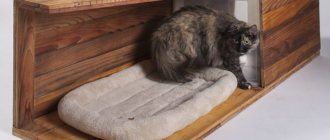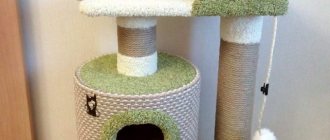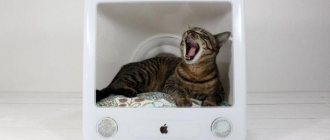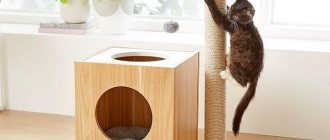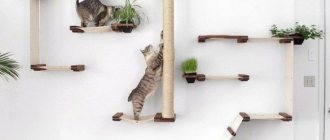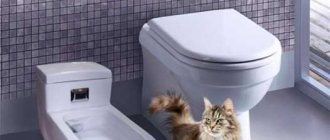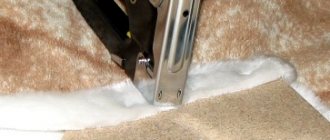Representatives of the cat world not only love to walk on their own, but also prefer to have their own home on the street. In such a structure they will be happy to wait out the summer heat or hide from the winter cold. Housing for pets is not always necessary, but in some cases it is simply necessary. An outdoor cathouse in winter helps her hide from the frost and protects her from dogs.
Owners who have several cats at once should take special care of the house. Keeping everyone in the house at once is not very convenient, but a cat house will immediately solve the problem.
Or, for example, a child or even an adult is allergic to cat fur, but wants to have a pet. So let the cat live in his own house! This is a good way out.
If you want to do a good deed to take care of animals that do not have owners, a cat house for the winter will also come in handy. Although, in addition to the house, they will also need food and water. In any case, housing will not hurt, but will only be a plus in your help to our little brothers. We'll tell you how to do it.
Materials
To build a house on a garden or summer cottage that will please the eye and surprise guests and neighbors with its architecture, you will need high-quality building materials:
- lining (for wall cladding),
- slats (for making a frame),
- plywood (you can use it to upholster the inside of the house),
- tongue and groove boards (for flooring),
- roofing felt or ondulin (for the roof),
- metal corners (for fastening structures).
Be sure to calculate the size of the house: too big is not needed - the cat will be uncomfortable and cool in it; too cramped is also not suitable - its occupant should be able to easily turn around inside and take a comfortable position (most often they focus on the parameters 1.5 x 1.2 x 0.5 m).
Based on the intended dimensions, stock up on the required amount of material. Also provide means to protect your cat's home from fungus so that the structure will last longer. And in order for a winter house to reliably warm its owner, the walls must be insulated with some suitable material.
To build a cat house with your own hands in the courtyard of a city residential building, you can focus on the economical option. Suitable building materials:
- a large cardboard box (as an option - an old bedside table that has become unnecessary);
- duct tape;
- pieces of foam;
- thick film or a piece of an old waterproof tablecloth.
What should an insulated winter house for cats be like?
- The main thing is to be warm and waterproof! What is important is not aesthetics for the human eye, but warmth for the cat. Make it look whatever you want on the outside, as long as it helps keep the cats warm!
- It is insulated inside with heat-insulating material: polyethylene foam, polystyrene foam, polystyrene foam, foam rubber (any material can be bought in sheets at construction stores).
- Raised above the ground to preserve heat, from snow drifts and water (30-40 cm will be enough). If the house will stand on legs, they must be stable.
- With a small entrance to preserve heat, approximately 15*15 cm. The entrance can be covered with a curtain.
- Small in volume so that approximately 4-6 cats, curled up in it, warm the house.
Tools
In addition to the traditional hammer and saw, it would be nice to use such modern tools as staplers (for nails and staples), a pneumatic hammer - the work will go faster and bring more pleasure. You will also need good scissors.
Step by step instructions 2
The structure will require three pillars: one 220 cm, the second – 120 cm and the third – 80 cm. On paper, mark the location of the supports, in which the longest one should be closer to the wall.
The pillars are arranged in a triangle from highest to lowest. Transfer the markings from the stencil onto the surface of the plywood. Attach each post with four long nails, drilling holes of a smaller diameter. Secure the outside supports with corners 55x20 for the large one and 35x40 for the remaining ones.
Then make the same markup for other platforms. A 12 mm feather drill will ensure a straight hole. The slots should be a couple of millimeters larger than the posts.
Create five to six platforms of any shape - maybe semicircular. Place the platforms on the posts and secure them at the desired level with the corners. At the end, cover the areas with carpet.
For the house you will need 2 sheets of plywood 75x50 cm, cut into 4 rectangles. The floor, roof and side walls are attached to each other with metal corners using short self-tapping screws. Make a semicircular hole on one of the walls - the future entrance.
Wrap the posts with rope. It is most convenient to attach the rope with staples and then wrap it tightly. To keep them tight, tap them with a hammer every few turns. The scratching posts are ready.
Option from boxes
An insulated outdoor house can be made from ordinary cardboard boxes. You will need two, which can be nested one inside the other like a nesting doll. There must be a small space between them. Newspapers or foam plastic are placed at the bottom of a large box; this is a good insulation. At the bottom of the smaller one (in which the animal will be located) - soft fabric, old items of clothing.
It is important that they are natural (cotton, flannel, or even better, fleece), and not synthetic, since synthetics do not keep you warm in cold weather.
Natural wool could be ideal for bedding, since it is warm, but it has one drawback - when wet (and this can happen if a cat brings snow into the house on its paws), its fibers take too long to dry.
INTERESTING TO KNOW: Do-it-yourself warm felted house for a cat
After the structure is insulated from the inside, the doors of the small (inner) box need to be closed, and an entrance must be cut out in its lid, in the corner. A convenient size is 14x14 cm. The edges of the inlet hole should be taped with tape so that they do not fray too quickly. The lid and walls of a large box will create a kind of canopy and protect the cat’s house from the wind along with its mustachioed and striped inhabitant.
Then you need to place the box in a thick plastic bag, press it against the walls of the large box, and seal the seams with wide tape.
Also use tape to secure the “canopy”. Then you will need to find a secluded place for the house, where rain, snow and wind do not reach. Do not place the structure directly on the ground, try to place it on boards or bricks, this will add reliability to it.
You can make a cat house from an old wooden box. One of the sides will become the base, and the open part will become the entrance. This “winter apartment” is placed on a tree, tightly screwed to the trunk and branches with twine, or on the ground. However, in the latter case, it is advisable to nail “legs” to the box - 10-20 cm bars. If they are stuck into the ground, the house will confidently stand on its “legs”.
If you have any unnecessary plastic container on hand, it is quite possible to build a house in it, providing insulation from the inside, as shown in the photo.
And also take a closer look at the body of an old unnecessary computer monitor or a large wicker basket - you can also use them to make a home for a cat.
: Connecting the house
When the box is ready, you need to secure the lid so that it does not come off during bad weather.
- In a well-ventilated area, apply glue around the perimeter of the lid Photo 1
- Align the lid with the box and apply slight force.
- Connect the lid and box with tape, make sure you do not block the drainage holes Photo 2
- Then wrap tape around the perimeter where the lid and box meet, this will help prevent possible displacement. Photo 3-5
Insulation with foam tiles
It is convenient to insulate a cardboard house with polystyrene boards. They are fastened with wide adhesive tape; it is very important to fix the parts well so that the structure does not “shake.” It is also important to design the entrance well: polystyrene foam should cover the cardboard completely (so that water does not get on it). The visor above it can be made of plexiglass or rubber.
The entire structure, as in the first option, must be tightly covered with a thick film or a piece of waterproof tablecloth. The seams must be taped in the same way.
Photo with dimensions
No matter how much we talk about the design of a cat house, the best way to understand the dimensions is by drawings with dimensions. If you look at them carefully, you will notice a solid run-up. This is understandable - there are large and small cats, and accordingly the size of the cat's house will be larger/smaller. You can adjust them yourself depending on the size of your pets or the available space.
Photos of cat houses with dimensions
Three options for cat corners with sizes
The height of the presented structures is quite large - 180 cm and above, but you can reduce it by removing floors that you think are unnecessary. All these dimensions can be taken as a basis to develop your own layout and put down approximate dimensions. Having the drawing in hand, you can begin purchasing materials and manufacturing.
“Capital” option
Such a house can be made by someone who is used to working with tools and building materials such as wood. They start, as they should, with the project, carefully thinking through all the details - the presence of internal partitions, the location of the window, the door.
INTERESTING TO KNOW: How to find out the age of a cat or kitten
The next step is to build a frame and fill it with some kind of insulation; polystyrene foam works very well (you can use packaging from household appliances or a computer). Then they move on to interior decoration - sheathing the walls of the structure from the inside with pieces of plywood. And after that they move on to the exterior decoration of the cat’s housing with clapboard. Do not confuse the order of these types of work - this is how you will do everything faster and better.
Then it’s time to connect the walls of the house with metal corners. The structure must be durable, since the animal will not want to move into the structure if it shakes. After this, they take the floor, a tongue-and-groove board was stored for it, and at the very end of the work, they take the roof.
If you place the finished structure at a height of 15 centimeters above the ground, the floor will freeze less, this will add comfort and warmth to the cat’s housing. The most convenient foundation is concrete cubes. They need to be covered with a layer of roofing felt, and only then the house should be placed on it.
How to arrange it?
In order for the new den to attract the cat even more, it is recommended to create all the conditions for a comfortable life inside. Equip the house with a cozy bed, scratching post, toys, bowls. There are individuals who are accustomed to pee exclusively in the litter box, even if there is a mountain of sand, so don’t forget about the cat potty. True, it is better to place this thing outside rather than inside, otherwise cleaning the toilet will take more effort and time. You can use an ordinary log or driftwood as a scratching post.
Useful tips and ideas
A house designed for not one, but two inhabitants should be either two-room or two-story. By the way, a building with internal partitions is much warmer than a one-room option.
Be prepared for the fact that the house needs to be cleaned from time to time. To simplify the process, you can open one of the walls like a door. Another option is a removable roof or a folding roof equipped with hinges.
The door of such a home should conveniently open from the inside and slam shut when the owner goes for a walk.
A cat in any circumstances, and especially when it finds itself in nature, begins to hunt. It is more convenient to observe the prey from a height, so a convenient observation post can be provided on the roof.
Don't try to make your cat's home too bright. Your pet will like his home more if it looks natural - just coat the boards with varnish and complete the exterior decoration.
* * *
A warm winter house for a cat is your opportunity to give a gift to your pet or help a mustachioed tabby who, by the will of fate, finds himself without a “permanent place of residence.”
The topic is actively discussed on the Internet, it also has opponents, but most of the participants in the discussion agree: if it is not yet possible to resolve the issue of placing all ownerless animals in nurseries, we need to help at least in this way - by building housing for cats and dogs. After all, they are our brothers. Smaller ones.
What to look for when choosing?
To build a winter house for a cat outside, you need the necessary tools and a workspace. However, not everyone has this opportunity. Manufacturers are increasingly realizing that the need for cat houses is constantly increasing. That's why they offer the most diverse types. Here's what you should pay special attention to so that the animal does not freeze:
- External finishing should be made of decorative boards or lining, and internal finishing should be made of plywood or other sheet material.
- In terms of structure, the type can be simple, made for temporary purposes, or two-story, larger in size, more spacious and more substantial in all respects. In these, the animal can comfortably spend the winter even in the coldest times.
- The presence of doors, windows, roofing, steps, etc.
You should also pay attention to ensuring that the floor, ceiling and walls are well insulated. In case of lack of heat, you can add additional insulation. It is necessary to take into account the fact that it is better to purchase and install a booth in advance, before the cold weather arrives. Because it will take some time to get used to and adapt to a new, cozy place where it’s warm and dry. Again, you need to consider the correct size of the housing and the entrance opening. If the room is large, then the cat simply will not be able to heat the interior space. It should be understood that the actual heating system for cat houses is the heat generated by the animal itself. However, choosing too small will also cause inconvenience. It is useful to consider how many inhabitants will live in it. The hole should be made by choosing the optimal size.
Peculiarities
So, to prevent Murka from choosing some unsuitable place to sleep, you need to take care of creating her own corner, and it is advisable to take into account the individual characteristics of the cat. So, some animals prefer to climb as high as possible, while others, on the contrary, try to crawl under a closet or bathtub. The love for tall objects is explained by instincts: when a predator can look down on its fellows, it feels in a more advantageous position, and the air temperature at an elevation is usually higher, since warm air rises. For those who like to take a position at the top, a house on a pole is ideal.
Compact furniture
This piece of furniture will be appreciated by owners who love to photograph their pets. Their sleeping places are real beds or sofas, only of miniature size. As a decoration, the crib is covered with a bedspread of unprecedented beauty, the pillows are embroidered with multi-colored patterns. A miniature crib that has become an exact copy of the owners’ bed will look impressive.
Comments3 comments
- Irina:
10/17/2017 at 01:33Hello! Thanks for the good advice. The house was built, everyone was accommodated (3 abandoned kittens), but trouble happened to one, the dog tore it to pieces and the others were scared and did not stay in the house for a long time. What to do, because winter is coming?
- Love:
10.24.2017 at 12:48
Thank you, useful information!
- Elena:
04/01/2018 at 22:31
Cool! Thanks for the advice. I'll definitely use it.
Step-by-step production of a complex for two cats
When an owner has two cats, it is necessary to build a house for them taking into account their behavior, and so that they do not interfere with each other. The behavior of cats can be different: some cats are friends and easily get along on the same site, and there are times when one of them dominates. In this case, we can assume that one of them will want to take the most comfortable and highest place. If the cats are not friends, then it is better to separate the platforms, but if they are friends, then you can build one common, but large platform at the very top of the structure.
Materials and finished house
For this design, plywood up to 12 mm thick is suitable, as well as pillars made of wooden beams measuring 50 by 70 mm and at least 4 meters long. You will also need a jute-based carpet, about 2 and a half square meters, and a rope up to 20 meters long. Corners with a side of 15 by 20 mm for the house and 40 by 45 mm for attaching platforms are suitable as fasteners. For fastening to the wall, you can use a pair of large corners, measuring 50 by 50 mm.
Fastening the main elements
The basis is a structure consisting of 3 pillars of different heights: 220 cm, 120 cm and 80 cm. The pillars are securely attached to the base, which is a plywood sheet. These load-bearing elements are placed so that the longest one is as close to the wall as possible in order to securely secure the entire structure. The placement of the posts is marked directly on the plywood sheet using a pencil. The posts can be secured using long nails driven into the back of the sheet, but first holes of the appropriate diameter are drilled for them. For reliability, the pillars are fastened with metal corners of the appropriate size.
Marking
Using the same method, holes are marked in the platforms through which the pillars should pass. It is better to make the holes slightly larger than the size of the posts, since they are still attached using corners. If the holes turn out to be somewhat smaller, then they will then have to be further processed either with a file, or a jigsaw, or sandpaper.
Fastening platforms
Before attaching the platform, it should be tried on and, if necessary, adjusted to size. It is desirable that the platform, and all other elements, be fixed strictly horizontally. To do this, you can use a building level. For reliability, the platform is attached using corners. After this, all platforms are covered with carpet, and this must also be done reliably, otherwise the animals will tear it away from the base.
House assembly
The body of the house is assembled from 4 rectangular pieces of plywood, which serve as the walls of the house, and a hole should be cut in one of the rectangles so that the cat can crawl through it. For the floor and roof, another rectangular section is cut out. To connect all the elements of the house, it is enough to use small metal corners and self-tapping screws. The fasteners must be such that none of the elements, especially the sharp ones, come out, although many of the fastener elements will be located under the skin.
Ship assembly
The most important thing is not to forget to upholster the house from the inside, after which you can fasten the roof, which is also sheathed with the same material. The finished house is attached to the planned location using the same metal corners as in the case of platforms.
Wrapping ropes around poles
The last stage is wrapping the poles with ropes, which will serve as scratching posts for the animals. In addition, design elements for animals will be more attractive. Before wrapping the rope around the pole, it is secured with a bracket. Staples are also used for intermediate fastening of ropes, as well as for final fastening. The rope should be wound tightly, otherwise it will loosen over time. To prevent this from happening, each turn or several are compacted at once with a hammer.
Wrapping poles with ropes
Building a cat house with your own hands does not take much time and can take no more than half a day, although more complex designs take much longer. In the following video you can see how a similar structure is assembled.
How I built a cat house with my own hands. The cat is SHOCKED! /How To Make a Cat House
Watch this video on YouTube
Bed tent
When you have two or more pets, you shouldn’t make one big house for them all. Each cat needs its own territory. Without a personal area, he feels left out and may become aggressive to assert his rights.
It is best to make a mini-town of several houses connected together. Such structures may contain ropes with balls, pipes and other entertainment elements.
Many ideas on how to make a cat house are difficult to master. The easiest option is to make separate beds for cats.
You will need:
- cardboard or plywood;
- 2 pieces of wire 7 mm thick;
- pillow;
- T-shirt
Where to install?
It is very important to decide on the correct location for the house. This must be an absolutely safe place for the animal.
Flooded areas should be avoided. The best option is to locate the building near the heat pipeline. This will give the cat an additional source of heat. You can put the house under the roof - this will protect the material from early wear.
If there is a doghouse on the property and the two pets do not get along, then place the cat shelter away from the dog. This way, your cat will feel safer and will be less bothered by dog barking. Try to hide the cat's kennel so that it is not visible to the human eye, as there may be ill-wishers among those around you. Place the structure as far as possible from recreation areas, grills, barbecues, and pools.
In the case where the structure was built for stray yard cats, it is important to agree with the house management on the possibility of installing the product. You cannot place the house in the yard; try to negotiate with those responsible for the house about placing the house on the local area, for example, on the lawn
For such a location, only the decision of the HOA and the consent of the residents of the 1st floor, in front of whose windows the building will be located, will be required.
Be sure to keep the area around the house clean. If you feed cats nearby, do not leave bags of cat food there, wash bowls, and remove waste products. These measures will help avoid disagreements with neighbors who are against cats being on the property. If people who are indifferent to the troubles of stray animals still threaten to destroy your building, put an inscription on it asking for compassion and a reminder that thanks to stray cats, the yard will be free of mice and rats that carry dangerous diseases for a long time.
